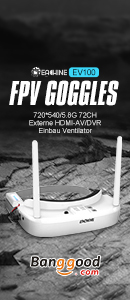Brushless Gimbal Controller
- Themenstarter RC FAN2
- Beginndatum
- Status
- Nicht offen für weitere Antworten.
ok I see that both board points to the same code link http://code.google.com/p/brushless-gimbal/downloads/list
I guess its just 2 different board layout with same software code
I guess its just 2 different board layout with same software code
RCDEVIL hat in sehr kurzer Zeit ein gut aussehendes GIMBAL entworfen, und es ist sehr interessant mitzulesen.
Dieser Thread ist jedoch ein Controller Thread von RCFAN2. Ich denke es ist i.O. wenn jemand einmal über sein Gimbal hier postet; er sollte aber auf sein eigenes Thread verweisen. Hierzu wurde RCDEVIL bereits von RCFAN2 längst aufgefordert, hat es aber abgelehnt. RCDEVIL leistet gute Arbeit, noch besser wäre ein eigener Thread hierzu.
Dieser Thread ist jedoch ein Controller Thread von RCFAN2. Ich denke es ist i.O. wenn jemand einmal über sein Gimbal hier postet; er sollte aber auf sein eigenes Thread verweisen. Hierzu wurde RCDEVIL bereits von RCFAN2 längst aufgefordert, hat es aber abgelehnt. RCDEVIL leistet gute Arbeit, noch besser wäre ein eigener Thread hierzu.
Dies kann RCFAN2 mit Sicherheit bestätigen.
Ja stimmt, das war Lonestar78 in diesem Post der ein eigene Thread gebeten hatte. Inzwischen Joe_hab und muvid ebenfalls.
Siehe es positiv: Der RCDevil Gimbal ist so interessant dass es sein eigener Thread haben könnte.
Und zum Thema Chinesen: die arbeiten bestimmt bereits daran alle Gimbals und Controller zu klonen, trotz Neujahr.
Siehe es positiv: Der RCDevil Gimbal ist so interessant dass es sein eigener Thread haben könnte.
Und zum Thema Chinesen: die arbeiten bestimmt bereits daran alle Gimbals und Controller zu klonen, trotz Neujahr.
Danke für die Richtigstellung, aber selbst Lonestar hat mich nicht aufgefordert einen eigenen Thread zu starten den ich abgelehnt hätte...
Ich finde den Vorschlag eigentlich richtig gut und es wäre toll wenn mehrere Ihr Gimbals dort vorstellen.
Also liebe Gimbal-Bauer startet den Thread, ich bin dabei.
Ich möchte ihn nicht unbedingt starten, sonst wird es evtl. als Schleichwerbung gesehen.

Ich finde den Vorschlag eigentlich richtig gut und es wäre toll wenn mehrere Ihr Gimbals dort vorstellen.
Also liebe Gimbal-Bauer startet den Thread, ich bin dabei.
Ich möchte ihn nicht unbedingt starten, sonst wird es evtl. als Schleichwerbung gesehen.
if someone is interested in Alex's russian board layout, I took pictures from underside too 
http://www.rcgroups.com/forums/showpost.php?p=24063479&postcount=635
http://www.rcgroups.com/forums/showpost.php?p=24063479&postcount=635
Zuletzt bearbeitet:
and how it works, testing for now.
soon I will be able to compare it with this open source controller, since I have both boards
http://www.youtube.com/watch?v=KUn-M5rJij0
soon I will be able to compare it with this open source controller, since I have both boards
http://www.youtube.com/watch?v=KUn-M5rJij0
if someone is interested in Alex's russian board layout, I took pictures from underside too 
http://www.rcgroups.com/forums/showpost.php?p=24063479&postcount=635
http://www.rcgroups.com/forums/showpost.php?p=24063479&postcount=635
Hi Tom & all, so Alex uses L6205 drivers which are 2 phase (2 full bridge) stepper motor drivers Vs. the 3 phase L6234 (3 half bridge) drivers in this open source project. This means that he must be combining one of the 2 pairs to form the 3 phase output of each of the L6205s or he is using 3 of the 4 half bridges (splitting the full bridge in 2 half bridges). Tricky.
I am going to have to save the circuitry for another post but suffice it to say here that the easiest implementation from the hardware stand point requires us to drive the winding either HIGH or LOW. That requires only three digital I/O pins and a very common H-bridge IC such as SN754410. There’s another possibility, too: we drive only two windings at a time and leave the third one open so no current is flowing through it and no magnetic force is generated, but that requires using 6 I/O pins and 6 discrete transistors. The benefit of the 6-pin scheme is better efficiency and torque due to lack of secondary, smaller magnetic forces pulling in the wrong direction.
http://elabz.com/brushless-dc-motor-with-arduino/
http://elabz.com/brushless-dc-motor-with-arduino/
maybe alex use this method as stated here
BTW: Nice video on how to control a BLDC
http://www.youtube.com/watch?v=szgVUfyX8JM&feature=player_embedded
maybe alex use this method as stated here
I am going to have to save the circuitry for another post but suffice it to say here that the easiest implementation from the hardware stand point requires us to drive the winding either HIGH or LOW. That requires only three digital I/O pins and a very common H-bridge IC such as SN754410. There’s another possibility, too: we drive only two windings at a time and leave the third one open so no current is flowing through it and no magnetic force is generated, but that requires using 6 I/O pins and 6 discrete transistors. The benefit of the 6-pin scheme is better efficiency and torque due to lack of secondary, smaller magnetic forces pulling in the wrong direction.
http://elabz.com/brushless-dc-motor-with-arduino/
I am going to have to save the circuitry for another post but suffice it to say here that the easiest implementation from the hardware stand point requires us to drive the winding either HIGH or LOW. That requires only three digital I/O pins and a very common H-bridge IC such as SN754410. There’s another possibility, too: we drive only two windings at a time and leave the third one open so no current is flowing through it and no magnetic force is generated, but that requires using 6 I/O pins and 6 discrete transistors. The benefit of the 6-pin scheme is better efficiency and torque due to lack of secondary, smaller magnetic forces pulling in the wrong direction.
http://elabz.com/brushless-dc-motor-with-arduino/
The logical output of the circuits though are principally the same: there are 3 output signals (pins) that are driven in sequence by the MCU to control the brushless motor(s) to keep stability based on the gyro feedback. These output signals go to the power driver ICs that have the necessary circuitry to directly drive the 6 windings (3 phases in star config with center unconnected so 2 couples of windings each). So until this point the logical circuit (Alex and open source) are the same.
The above post refers to 2 different configurations: a discrete driver which is made out of 6 transistors or FETs, 3 couples (3 half bridges), just like the L6234 has except that they are packaged in this IC for integration, and a 2 x half bridge driver (SN754410) which is typically used for stepper motors or 2 phase motors, like Alex style.
I was just wondering how Alex used the L6205 outputs and why he chose this driver instead of a classical 3 phase driver like the L6234. I believe he uses 3 half bridge outputs to drive the 3 phases, 2 at a time effectively using 6 of the 8 half bridges in the L6205, but there are other possibilities. The only way to know is to analyse how he drives the inputs.
ST L6234 datasheet (3 Half bridges):
http://www.st.com/internet/com/TECHNICAL_RESOURCES/TECHNICAL_LITERATURE/DATASHEET/CD00000046.pdf
ST L6205 datasheet (2 full bridges):
http://www.st.com/internet/com/TECHNICAL_RESOURCES/TECHNICAL_LITERATURE/DATASHEET/CD00002345.pdf
L6205 App note:
http://www.st.com/internet/com/TECH...AL_LITERATURE/APPLICATION_NOTE/CD00004482.pdf
TI SN754410:
http://www.ti.com/lit/ds/symlink/sn754410.pdf
So liebe Freunde , in 8 Arbeitstagen bekomme ich eine "größere" Lieferung Brushless Gimbal Platinen 
Preislich wird sich das ganze dann wie bei Marinz einreihen .....
Parallel dazu werde ich den ersten Post in diesem Thread und die Homepage etwas aufräumen um Anfängern einen leichteren überblick zu verschaffen.
Wenn die nachfrage besteht , werde ich auch nochmal einen schwung Motoren wickeln lassen .
Preislich wird sich das ganze dann wie bei Marinz einreihen .....
Parallel dazu werde ich den ersten Post in diesem Thread und die Homepage etwas aufräumen um Anfängern einen leichteren überblick zu verschaffen.
Wenn die nachfrage besteht , werde ich auch nochmal einen schwung Motoren wickeln lassen .
- Status
- Nicht offen für weitere Antworten.


